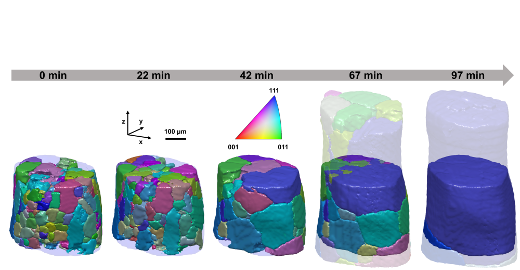
Dynamics of particle-assisted abnormal grain growth
Abnormal grain growth may occur at elevated temperatures in materials such as metals and ceramics. This is undesirable as it limits the lifetime of components. To overcome abnormal grain growth, secondary-phase particles can be added during fabrication. These particles pin the grain boundaries and prevent grain growth. However, abnormal grain growth has been observed even in the presence of particles.
A group of researchers headed by Prof. Ashwin Shahani from University of Michigan set out to better understand the dynamics of this unwanted and unexpected process. Through LabDCT they were able to capture the evolution of grains in an Al-Cu alloy during five step of interrupted annealing at 485°C. This information was complemented with the distribution of particles measured by absorption contrast tomography. By integrating the results it was determined that larger grains were found in regions of lower particle density and vice versa. Once a grain in a particle-poor region develops a size advantage, it may grow to consume the entire sample volume. Based on the experimental observations, a novel analytical model was set up to predict and prevent abnormal grain growth conditions.
Acta Materialia
By the same authors
Grain boundary percolation studied by LabDCT
Harnessing LabDCT to understand dynamics of liquid metal penetration
